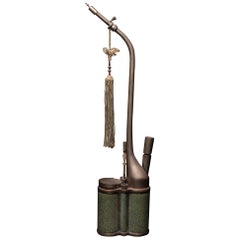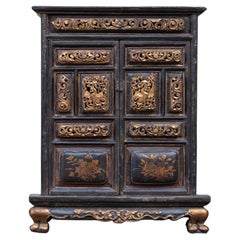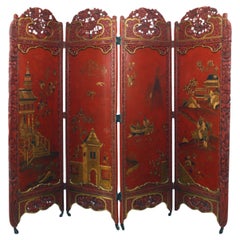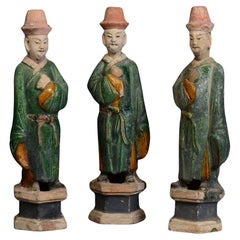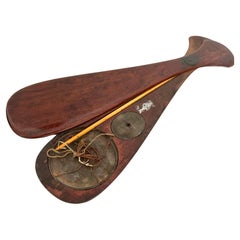Chinese Antiquities
to
90
492
151
708
4
2
1
1
1
1
1
249
274
185
4
91
21
3
17
2
4
2
2
2
1
326
200
161
112
60
1,826
1,285
712
373
370
712
712
712
3
2
2
1
1
Place of Origin: Chinese
Nineteenth Century Chinese Metal Water Pipe, Covered with Green Dyed Ray Skin
Located in Leuven , BE
The Chinese water pipes for smoking opium or tobacco could be beautifully decorated with enamel or be coated with precious materials such as ray skin. How were they used? The heated opium was placed in the lidded well of the pipe. The smoker could inhale the fumes through this pipe. Most water pipes have a holder for storing the maintenance tools, such as a little brush, a spike and tweezers. The water pipes could easily be smoked while sitting down, unlike the regular opium pipes...
Category
19th Century Antique Chinese Antiquities
Materials
Metal
19th Century Chinese Small Altar Cabinet
Located in Singapore, SG
An antique carved box from Chaozhou city, in Guangdong, China. The black and gold colours, as well as the bulbous designs on the front are all disti...
Category
1880s Qing Antique Chinese Antiquities
Materials
Pine
Tibetan Buddhist Handcrafted handheld Spinning Prayer wheel
Located in Pomona, CA
This is handcrafted Tibetan copper handheld spinning Prayer Wheel. It has detailed handcrafted Tibetan traditional design with Coral inlay. Was used in daily pray. Look at the pictur...
Category
Mid-20th Century Chinese Export Chinese Antiquities
Materials
Copper
Chinese Red Lacquered 4-Fold Screen with Carved Floral Frame
Located in Queens, NY
Chinese style (19th/20th century ) red and gold lacquered 4 fold screen featuring a carved floral frame and a Chinoiserie design.
Antique Condition prior repairs
Category
19th Century Chinese Export Antique Chinese Antiquities
Materials
Lacquer
Ming Dynasty, A Set of Antique Chinese Green Glazed Pottery Standing Court Man
Located in Sampantawong, TH
A set of antique Chinese green glazed pottery standing court man.
Age: China, Ming Dynasty, A.D. 1368 - 1644
Size: Height 36.8 - 37.5 C.M. / Width 10 C.M. / Depth 10.5 - 11 C.M.
Con...
Category
15th Century and Earlier Antique Chinese Antiquities
Materials
Pottery
19th Century Huanghuali Chinese Opium Scale
Located in Atlanta, GA
Beautifully carved scale box from the much desired Huanghuali wood.
These scales were originally used to weigh herbs, medicines, and precious metals, but are known as opium scales...
Category
Late 19th Century Antique Chinese Antiquities
Materials
Brass
Antique Qing Dynasty Chinese Twin Handled Bronze Censer Xuande Marks to Base
Located in Brea, CA
Qing dynasty 18th century Chinese twin handled bronze censer bearing XuanDe marks to base , 990 grams , 17cm wide, internal width 10cm , 7cm high.
Category
Late 18th Century Qing Antique Chinese Antiquities
Materials
Bronze
Chinese multicolor porcelain vase, 19th c.
Located in New York, NY
wooden base is not included with this lot; continuous figural scene
Category
Mid-19th Century Antique Chinese Antiquities
Materials
Porcelain
Chinese Tang Dynasty Pottery Court Lady
Located in Austin, TX
Painted pottery figure of an opulent Chinese court woman with up-swept hair and standing in a simply draped robe from the Tang Dynasty (618-907 AD). Her beauty is illuminated by the ...
Category
15th Century and Earlier Tang Antique Chinese Antiquities
Materials
Pottery, Acrylic
Provincial Chinese Trunk Mortar, c. 1900
Located in Chicago, IL
This large wooden mortar dates to the late 19th century and was originally used for crushing rice, grain, spices and other foodstuffs. Carved from a single tree trunk, the mortar has...
Category
Late 19th Century Primitive Antique Chinese Antiquities
Materials
Wood
Qing Dynasty Rare Chinese Famille Rose Porcelain Vase Yellow Ground Enamel Panel
Located in Brea, CA
Qing Dynasty an antique rare early 20th century Chinese porcelain vase as a Chinese Famille Rose lamp with incised yellow ground decorated wi...
Category
Early 20th Century Qing Chinese Antiquities
Materials
Porcelain
18th Century Chinese Imari Plate
Located in Delft, NL
18th Century Chinese Imari plate
A Kangxi, Imari underglaze blue plate with scene of peonies and gold and red painted , bamboo and deer
1662-17...
Category
18th Century Antique Chinese Antiquities
Materials
Porcelain
19th Century Antique Gilt Lacquer Chinese Tea Caddy
Located in Brea, CA
19th century golden black lacquer Chinese tea caddy with two pewters with 4 foots, the gilt body decorated with panels of landscapes, two pewters with covers, one pewter lead ring...
Category
Mid-19th Century Qing Antique Chinese Antiquities
Materials
Lacquer
Pair of 19th Century Chinese Bronze Cloisonné Urns
Located in Houston, TX
Pair of late 19th century Chinese bronze cloisonné urns with lids
Category
Late 19th Century Antique Chinese Antiquities
Materials
Bronze, Enamel
Tang Dynasty Painted Pottery Horse and Rider, TL Tested
Located in Austin, TX
A charming Tang dynasty painted pottery figure of a horse and mounted noble rider. TL tested by Oxford Authentication.
The horse portrayed standing fours...
Category
15th Century and Earlier Tang Antique Chinese Antiquities
Materials
Earthenware
Antique Chinese Opium Lamp with Round Base that is Multi-lobed
Located in Leuven , BE
Opium smokers used opium lamps to make the vaping and inhaling of the opium easier. These lamps, which contained spirits in their base, were specifically de...
Category
20th Century Chinese Antiquities
Materials
Brass
Chinese Antique mother of Pearl shell silver caviar dish Asian arts
Located in London, GB
A particularly fine Chinese mother of pearl dish with silver bird decoration the underside with silver ball feet
Period Early 20th century
Category
Early 20th Century Chinese Antiquities
Materials
Silver
Antique Asian Water Pipe Yellow Copper, Tortoiseshell Scale, Tobacco Collectible
Located in Leuven , BE
Antique Chinese Water Pipe in Yellow Copper, decorated with Tortoiseshell Scales. The Rectangular Base gives this Object its Elegance.
French Private...
Category
19th Century Antique Chinese Antiquities
Materials
Copper
Chinese Six Dynasties Pottery Model of an Armored Horse, 3rd-4th Century, China
Located in Austin, TX
An extremely rare Chinese painted pottery model of an armored horse, Six Dynasties period (220-581 AD), TL tested by Oxford Authentication.
The stocky ...
Category
15th Century and Earlier Antique Chinese Antiquities
Materials
Pottery
Yuan Dynasty, Antique Chinese Green Glazed Pottery Covered Jar
Located in Sampantawong, TH
Chinese green glazed pottery covered jar.
Age: China, Yuan Dynasty, A.D. 1271 - 1368
Size: height 35 cm / width 25 cm.
Condition: Wel...
Category
15th Century and Earlier Antique Chinese Antiquities
Materials
Pottery
Large Early Tang Dynasty Painted Pottery Model of a Prancing Horse, TL Tested
Located in Austin, TX
A magnificent and large early Tang dynasty (618-906 AD) model of a prancing or dancing horse, circa 7th century.
The majestic animal is caught mid-motion, one leg raised, head grace...
Category
15th Century and Earlier Tang Antique Chinese Antiquities
Materials
Pottery
Antique Pair of Chinese Porcelain Vases
Located in Brea, CA
A pair of antique Chinese porcelain vases with very beautiful hand paint. Excellent condition, measures: 12” x 8 '', the mouth of the vase is 5.5'', the bottom of the vase is 6.5, se...
Category
Early 20th Century Qing Chinese Antiquities
Materials
Porcelain
Rare Antique Qing Dynasty Chinese Gilt Silver Filigree And Enamel Brise Fan
Located in Brea, CA
Rare Fine Antique early 19th century Chinese gilt silver filigree and enamel brise fan , Qing dynasty, the fan has 22 sticks with a 18k gold ring loop , wond...
Category
Early 19th Century Qing Antique Chinese Antiquities
Materials
Silver, Enamel
3 Chinese porcelain spoons, 19th c.
Located in New York, NY
the two spoons decorated with fish motif are decorated in relief; a dragon-motif decorated spoon
Category
Mid-19th Century Antique Chinese Antiquities
Materials
Porcelain
Pair of 20'' Chinese Jade Bonsai Tree in Gilt Cloisonné Pot
Located in Brea, CA
Antique a pair of Chinese multi-color jade and agate bonsai tree in gilt cloisonné pot, very excellent and nice, measures: 20" tall x 18" x 12".
Category
Mid-20th Century Chinoiserie Chinese Antiquities
Materials
Jade, Agate
Antique 19th Century Chinese Lacquer Sewing Box with the Stand
Located in Brea, CA
Antique 19th century Chinese lacquer sewing table with hand painted scenes and beautiful legs. Gilt export black lacquer all-over the tabl...
Category
Late 19th Century Qing Antique Chinese Antiquities
Materials
Lacquer
Massive Chinese Eastern Han Dynasty Impressed Pottery Jar '25-220 AD'
Located in Austin, TX
A stunning and massive Chinese high fired gray pottery jar of remarkable size and girth, with impressed geometric design, Eastern Han Dynasty (25-220 AD), ...
Category
15th Century and Earlier Han Antique Chinese Antiquities
Materials
Pottery
19th Century Pair of Chinese Carved Rosewood Flower Stands Marble-Top
Located in Brea, CA
19th century a pair of antique 31.5” large Chinese rosewood flower stands marble top insert, 2 pieces, the inset marble-top over carved rosewoo...
Category
Late 19th Century Chinese Export Antique Chinese Antiquities
Materials
Hardwood
Antique Tibetan Buddhist Handcrafted handheld Spinning Prayer wheel
Located in Pomona, CA
This is handcrafted Tibetan handheld spinning Prayer Wheel. This spinning prayer wheel was made from Sky Iron and has detailed handcrafted Tibetan traditional design with Copper wire...
Category
Early 20th Century Chinese Export Chinese Antiquities
Materials
Metal
Tibet Vintage Pair Amulet Pendants Two And Nine Eye Dzi Beads
Located in South Burlington, VT
A unique pair (2), valuable and powerful Protection Amulet Dzi from Tibet
An old Tibetan or Central Asian two and nine eye agates Dzi Beads dating to the e...
Category
20th Century Qing Chinese Antiquities
Materials
Agate
Antique Chinese Multi-Lobed Opium Box in Silver, Decorated with Reliefs with Ide
Located in Leuven , BE
Beautiful opium box decorated with reliefs with ideograms (one of the two refers to wealth), a chrysanthemum (symbol of longevity) and foliage. This silver m...
Category
19th Century Antique Chinese Antiquities
Materials
Silver
Antique Asian Chinese Opium Box Cloisonné Enamel, Tobacco Snuff Box Floral Motif
Located in Leuven , BE
Old Chinese Opium Box in Cloisonné Enamel, decorated with Vases and Flowers.
French Private Collection
Category
19th Century Antique Chinese Antiquities
Materials
Metal
Antique Terracotta Chinese Figures Statues
Located in Alessandria, Piemonte
Antique terracotta figures Han style from my private collection: collected about 35 years ago and never exibited to the public.
One is very ancient, the other one is more recent. The prices are different, but an expert can understand the value. A certificate Oxford test would be needed: I don't have it, so I'm accepting offers: I want to close my activities and I have a beautiful Chinese collection, see the other ones published under my name enrica pasino.
Category
15th Century and Earlier Han Antique Chinese Antiquities
Materials
Terracotta
18th Century Gilt Black Chinese Larquer Cabinet Desk
Located in Brea, CA
18th century gilt black lacquer Chinese cabinet desk, the rectangular-section body decorated with panels of landscapes, the superstructure of two panelled doors, enclosing an array o...
Category
Early 18th Century Qing Antique Chinese Antiquities
Materials
Lacquer
Chinese Qin Dynasty Style Life-Size Kneeling Terracotta Soldier Statue
Located in Queens, NY
Chinese Qin Dynasty-style (20th Century) life-size terracotta soldier statue kneeling on a rectangular base. (Head is removable)(Companion piece: NW...
Category
20th Century Chinese Export Chinese Antiquities
Materials
Terracotta
Pair of Chinese Blue/White Porcelain Ginger Jars
Located in Queens, NY
PAIR of Asian Chinese (20th Century) blue and white porcelain temple / ginger jars with round lids, and hexagonal bases, featuring figures and a floral pattern (PRICED AS PAIR)
Category
20th Century Chinese Export Chinese Antiquities
Materials
Porcelain
Chinese Coconut tea pot - China - late 18th / early 19th - Qing - Asian Art
Located in Beuzevillette, FR
Very pretty and old tea pot, gourd shaped, in sculpted coconut, chiseled and mounted on pewter.
The cap is also made of pewter.
The coconut is decorated with imperial motifs.
Chinese...
Category
19th Century Qing Antique Chinese Antiquities
Materials
Tin
Nineteenth Century Chinese Metal Water Pipe, Covered with Green Dyed Ray Skin
Located in Leuven , BE
The Chinese water pipes for smoking opium or tobacco could be beautifully decorated with enamel or be coated with precious materials such as ray skin. How were they used? The heated opium was placed in the lidded well of the pipe. The smoker could inhale the fumes through this pipe. Most water pipes have a holder for storing the maintenance tools, such as a little brush, a spike and tweezers. The water pipes could easily be smoked while sitting down, unlike the regular opium pipes...
Category
19th Century Antique Chinese Antiquities
Materials
Metal
Chinese White and Blue Octagonal Porcelain Pot
Located in Queens, NY
Chinese white and blue porcelain octagonal pot painted with a unique figurative vignette in each panel beneath a floral design leading up to the opening.
Condition: Good; Wear consi...
Category
20th Century Chinese Export Chinese Antiquities
Materials
Porcelain
Pair of Chinese Porcelain Moon Flask Form Vases, 19th Century
Located in New York, NY
figural scene on one side, and bird, flower, butterfly motif on the other side
Category
Mid-19th Century Antique Chinese Antiquities
Materials
Porcelain
Pair of Chinese Iron Bound Courtyard Doors, c. 1900
Located in Chicago, IL
This impressive set of doors dates to the turn of the century and originated as the outermost entrance gate to a traditional courtyard home in northern China. Crafted of locust wood and hand-worked iron, the rustic doors have developed a fantastic texture from years of use. The original layer of dark brown lacquer has eroded with an inimitable crackle, revealing the beautiful wood grain underneath.
The door fronts are reinforced with studded iron bands and decorative iron plates in the shape of clouds or ruyi. The doors are fitted with a simple iron latch and four round door pulls...
Category
Late 19th Century Qing Antique Chinese Antiquities
Materials
Iron
19th Century Chinese Gilt Lacquer Fan with Mother of Pearl Faces and Lacquer Box
Located in Brea, CA
Antique 19th century hand painted Chinese fan with mother of pearl faces, Qing dynasty, the fan features black and gold lacquered handled a colorful screen with a figural, hand painted, scene with antique lacquer fan box...
Category
1850s Qing Antique Chinese Antiquities
Materials
Lacquer
Jadeite Carving of a Standing Lady, China, 20th Century
Located in Roma, IT
This jadeite carving of a standing lady was realized in China in the 20th century.
Realized in green jadeite, this precious statue is carved in the ...
Category
20th Century Chinese Antiquities
Materials
Jade
Early 20th Century Chinese Faux Ivory Carved Earthquake Detector, Seismograph
Located in Pomona, CA
Chinese seismograph was invented by Zhang Heng in about Eastern Han Dynasty. According to the history, The seismograph has eight directions, which are east, south, west, north, south...
Category
Early 20th Century Chinese Export Chinese Antiquities
Materials
Bone
Early 20th Century Chinese Tiger Eye Snuff Bottle
Located in Barcelona, ES
Early 20th century Chinese snuff bottle. Bottle and tap made out of tiger eye stone.
Category
Early 20th Century Chinese Antiquities
Materials
Agate
19th Century a Pair of Chinese Fan with Frame Box
Located in Brea, CA
Antique 19th century a pair of silk Chinese fans, Qing dynasty with fan frame box. Fan is 18inch x 10'' x 2''.
Category
1850s Qing Antique Chinese Antiquities
Materials
Silk
1960s Chinese Cloisonné Egg Black Enamel Inlay Chrysanthemum & Butterflies
Located in Andernach, DE
Intricately detailed Cloisonné egg of ''regular'' size in black, pink, golden yellow & greens.
The metal filigree in brass: beautifully detailed with a b...
Category
Mid-20th Century Chinese Export Chinese Antiquities
Materials
Brass, Enamel
Paire de lanternes Chine
Located in VILLENEUVE-LÈS-AVIGNON, FR
Paire de lanternes en bois exotique sculpté et ajouré de personnages sur papier de riz appliqué sur verre.
Chine 19ème siècle
Category
Mid-19th Century Other Antique Chinese Antiquities
Materials
Glass, Wood
Kintsugi Porcelain Opium Pillow
Located in MEAUX, FR
Rediscovered History & Beauty: Kintsugi Porcelain Opium Pillow
Discover a fascinating and historically rich art object: a blue and white porcelain opium pillow. This astonishing pie...
Category
2010s Chinese Antiquities
Materials
Porcelain
Late Ming Era Documented Glazed Pottery Horse
Located in Kastrup, DK
An elegant Chinese Ming dynasty pottery figurine depicting a horse in a standing pose with polychrome finish (aubergine, light brown and g...
Category
17th Century Ming Antique Chinese Antiquities
Materials
Pottery
Large Cast Iron Tub with Floral Motif
Located in Greenwich, CT
Large cast iron tub with floral motif with four ring pulls, there is one casted inscription on one side with date made : " Emperor Qianglong Era 32nd yea...
Category
Late 19th Century Qing Antique Chinese Antiquities
Materials
Iron
Han Dynasty, Antique Chinese Pottery Hu Jar
Located in Sampantawong, TH
Chinese pottery Hu jar decorated with bands of raised lines and a pair of monster masks on the shoulder.
Age: China, Han Dynasty, 206 B.C. - A.D.220
Size: h...
Category
15th Century and Earlier Antique Chinese Antiquities
Materials
Pottery
Northern Wei Dynasty Terracotta Horses, TL Tested, '386 AD-535 AD'
Located in Miami, FL
A massive pottery pair of horses standing on all fours and striding with its right hoof forward. Extended snout ends in parted lips showing teeth beneath in a braying attitude. Low relief bridle on face and well defined eyes. Raised mane down back of the neck
A fantastic example of the Wei dynasty horses.
Large, exquisite walking Ferghana horses with great attention paid to anatomical detail were the choice of the wealthy. The horse was second only in importance to the dragon. It was supposed to possess magical powers which the early Chinese were eager to explore. It would be the horse that would carry the deceased to the next life and it would be the amount of horses that an individual owned that would guarantee his ongoing status in the hereafter.
Thermoluminescence certificate from Madrid Labs included.
In southern China, people turned to Daoism, and mingqi, as well as above-ground sculptures, became ever more infused with animal iconography and energized with dynamic lines.
The north of China was eventually united by nomadic Tuoba invaders who founded the Northern Wei dynasty...
Category
15th Century and Earlier Han Antique Chinese Antiquities
Materials
Terracotta
18th/19th Century Bronze Tibetan Altar Piece - 8629
Located in Ukiah, CA
Beautiful 18th/19th century bronze Tibetan Altar Piece. I've not seen one like this before. Very sweet well cast elephant on top, with a copper bridle. T...
Category
Late 18th Century Antique Chinese Antiquities
Materials
Bronze
Pair of Chinese Decorated Lacquered Cabinets
Located in Queens, NY
PAIR of Asian Chinese (19th Century) decorated lacquered small 2 door cabinets with scenes and figures on rectangular stands with filigree corners and shelf (PRICED AS PAIR).
Category
19th Century Chinese Export Antique Chinese Antiquities
Materials
Lacquer
Big Pair of Chinese Hand Painted Porcelain Vase
Located in Brea, CA
Pair of antique 20th century Chinese hand painted porcelain vase. One has rim short light hair line inside, outside no hair line, s...
Category
1960s Art Deco Vintage Chinese Antiquities
Materials
Porcelain
Inside Painted Glass Snuff Bottle by Ye Zhongsan, Dated to Late Qing Dynasty
Located in Tainan, TW
Ye Zhongsan (1869-1945) was born in the late Qing Dynasty and lived in Beijing his entire life, and the generations in Ye Family were officials at that time. Among the traditional in...
Category
Early 20th Century Qing Chinese Antiquities
Materials
Glass
Qing dynasty 2 tier pagoda birdcage
Located in Waxahachie, TX
Free shipping
Qing dynasty
Stunning statement piece in any room
2 tier floating pagoda birdcage
Highly carved and detailed
Dragons, flowers, fish...
Category
Early 20th Century Qing Chinese Antiquities
Materials
Wood
Chinese Antique Gourd-Shaped Blue and White Porcelain Vase, Ming Period
Located in Chuo-ku, Tokyo
The bottom sign tells this vase was made in the era of Xuande emperor.
The characteristic Arabic pattern is Influenced by the Silk Road trade in Ming p...
Category
17th Century Ming Antique Chinese Antiquities
Materials
Earthenware
Pair Cinnabar Urns, Original Carved Wood Stands, China, Late 19th Century
Located in Southbury, CT
A gorgeous pair of late 19th century carved cinnabar urns with their original hand-carved rosewood stands. The 17" tall urns are a perfect match, though not identical. Each side disp...
Category
Late 19th Century Art Nouveau Antique Chinese Antiquities
Materials
Wood
Mid 20th Century Chinese Cloisonne Snuff Bottle with Scoop
Located in Pomona, CA
This Chinese Cloisonne Master Snuff Bottle was hand crafted with beautiful phoenix motifs on both sides of the snuff bottle. A snuff bottle is a snuff container that can be easily ha...
Category
Mid-20th Century Chinese Export Chinese Antiquities
Materials
Copper
Provincial Chinese Trunk Mortar, c. 1900
Located in Chicago, IL
This large wooden mortar dates to the late 19th century and was originally used for crushing rice, grain, spices and other foodstuffs. Carved from a single tree trunk, the mortar has...
Category
Late 19th Century Rustic Antique Chinese Antiquities
Materials
Iron
Tibet Vintage Pair Amulet Pendants Nine And Four Eye Dzi Beads
Located in South Burlington, VT
A unique pair (2), valuable and powerful Protection Amulet Dzi from Tibet
An old Tibetan or Central Asian nine and four eye agates Dzi Beads dating to the ...
Category
20th Century Qing Chinese Antiquities
Materials
Agate
Rare 19th Century Chinese Porcelain Brush Pot for Vietnam
Located in MEAUX, FR
Rare 19th Century Chinese Porcelain Brush Pot for Vietnam, Enhanced with 22k Gold Kintsugi Restoration
Immerse yourself in the history and elegance of this rare Chinese porcelain...
Category
19th Century Antique Chinese Antiquities
Materials
Porcelain
19th Century Gilt Lacquer Chinese Tea Caddy
Located in Brea, CA
19th century golden black lacquer Chinese tea caddy with a key, the rectangular-section body decorated with panels of landscapes and patterned decoration throughout retains original ...
Category
Early 19th Century Qing Antique Chinese Antiquities
Materials
Lacquer
Antique 19th Century Small Chinese Lacquer Sewing Table
Located in Brea, CA
Antique 19th century small Chinese lacquer sewing table with hand painted scenes and beautiful legs. Gilt export black lacquer all-over th...
Category
Mid-19th Century Qing Antique Chinese Antiquities
Materials
Lacquer
Antique 18th Century Export Chinese Lacquer Gaming Box
Located in Brea, CA
Antique 18th century export Chinese lacquer gaming box with hand painted scenes gilt export black lacquer, there are 7 gaming boxes and 12 trays, size: ...
Category
Late 18th Century Qing Antique Chinese Antiquities
Materials
Lacquer
Pair of brown glazed ceramic elephants, garden stools or plant holders, China
Located in Beuzevillette, FR
Pretty pair of very decorative garden stools or plant stands or side tables in the shape of Asian elephants.
Hand painted ceramic.
The elephants are in ceremonial dress...
Category
Mid-20th Century Chinese Antiquities
Materials
Ceramic, Porcelain
Unique 19th Century Export Chinese Gilt Chinoiserie Lacquer Box
Located in Brea, CA
Unique 19th century export Chinese gilt chinoiserie lacquer box with hand painted scenes gilt export black lacquer, this box has a unique shape, it is f...
Category
Mid-19th Century Qing Antique Chinese Antiquities
Materials
Lacquer
Complete Antique Chinese Water Pipe in Paktong
Located in Leuven , BE
Complete Antique Chinese Water Pipe in Paktong (=an Alloy of Zinc, Copper and Nickel). The Base is decorated with fine plates in Bamboo and Red Copper. It is also provided with Ideog...
Category
20th Century Chinese Antiquities
Materials
Copper, Nickel, Zinc
Chinese Carved white jade disc with openwork decoration on a wooden base, Qing
Located in Bilzen, BE
Antique 19th century Chinese disc carved in white jade on its original carved wooden base.
Qing period
In very good condition, diameter of the jade 5.5 ...
Category
19th Century Qing Antique Chinese Antiquities
Materials
Jade
Chinese Ancient Hand Carved Unicorn
Located in South Burlington, VT
A Chinese hand carved and hand painted wooden effigy of an extraordinary unicorn dating to the Song dynasty before 1279 AD.
Please enjoy the beautiful remnants of its aged original ...
Category
15th Century and Earlier Antique Chinese Antiquities
Materials
Wood
Chinese Dian Culture Large Gold Cuff, circa 2nd Century BC, Southern China
Located in Austin, TX
A large and impressive solid high karat gold cuff from the Dian Kingdom, circa 2nd century BC, modern day Yunnan Province, China.
.
This striking cuff is crafted from hand hammered ...
Category
15th Century and Earlier Han Antique Chinese Antiquities
Materials
Gold
